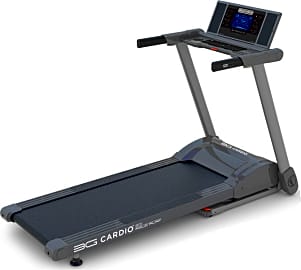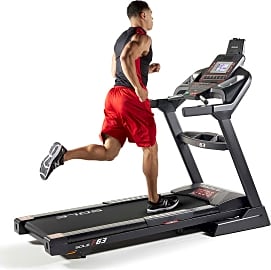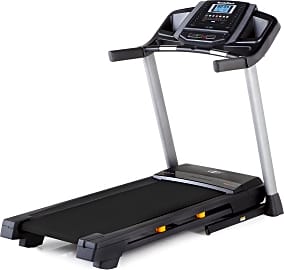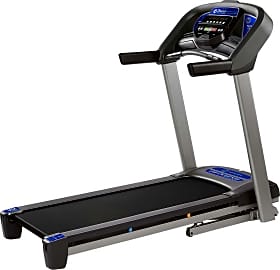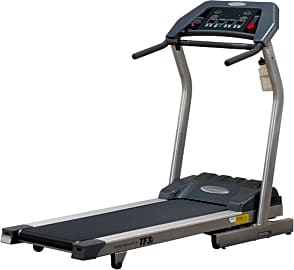The 10 Best Folding Treadmills

This wiki has been updated 36 times since it was first published in November of 2016. If you want to enjoy a rigorous exercise routine from the comfort of home, but you're worried about the lack of storage space for equipment, you should consider one of these folding treadmills. In addition to having the same capabilities and sturdy running decks as many of their gym equivalents, they can be unobtrusively placed against a wall or stashed under a bed when not in use. When users buy our independently chosen editorial selections, we may earn commissions to help fund the Wiki.
Editor's Notes
March 10, 2020:
As I mentioned during my update of the best treadmills, it’s very hard to run on a narrow track, and, as a matter of safety and comfort, you preferably want something that’s at least 20 inches wide. Obviously, larger treadmills tend to be less budget-friendly and less portable, so I am willing to make a few exceptions when it comes to prioritizing portability. Thus, during this update, I replaced the models with the smallest tracks in the list, like the Sunny Health & Fitness SF-T4400 and Efitment T012 with models with larger tracks, like the Sole Fitness F80 and NordicTrack 1750. In fact, all of the 4 new treadmills I’ve introduced have tracks of at least 20-by-55 inches. At the same time, I’ve made a few minor exceptions by leaving in models with smaller tracks, the smallest of which is the Marcy JX-650W with a 16.5-by-47.2-inch running surface. The Endurance TF3i and 3G Cardio 80 also have narrower tracks, but theirs are around 18 inches, which is a little more comfortable.
Fortunately, nowadays, you do have some great professional foldable models with large running tracks and high-end features made for the demanding schedules of seasoned runners and very fit athletes who regularly perform HIIT workouts, the most notable of which is the NordicTrack 1750. Like the 1750, I’ve decided to highlight other low-end models in treadmill series’, in order to stay in theme with this list and prioritize portability; conversely, I would instead highlight models like the NordicTrack 2450 and 2950 in a list like the best overall treadmills.
I’ve therefore also removed the previously-listed Sole F85 and highlighted both the Sole F80 and Sole F63. Both models are great mid-to-low-range treadmills that offer large running tracks and relatively uncluttered panels – if NordicTrack makes some of the best overall high-end treadmills, then Sole Fitness is perhaps NordicTrack’s equivalent for portable and foldable treadmills with decent track sizes.
Though treadmills with larger tracks tend to be more expensive than your generic Chinese-made treadmills with small tracks, I speak from experience when I say that it’s definitely worth the investment, and nowadays you can get budget-friendly options like the Horizon Fitness T101 with ample running areas for only around $600, which is only a little bit more than what one of those crappy models with a small track would cost you.
A Brief History Of Treadmills
This was basically several horizontal bars attached to a vertical shaft that, when pushed, was able to lift heavy objects or buckets of water out of a well.
It should not come as a surprise that the treadmill was originally invented as a torture device.
During the height of the Roman Empire, slaves were forced to push what was known as a tread wheel. This was basically several horizontal bars attached to a vertical shaft that, when pushed, was able to lift heavy objects or buckets of water out of a well.
Of course, using animals like mules or oxen was much more efficient, and so the treadmill fell out of favor until 1818, when a British engineer named Sir William Cubitt found a much more humane use for it...wait, no, it was still used for torture.
Cubitt, outraged that prisoners were sitting around idle when they could be improving their physiques and performing useful labor, devised a contraption that worked like an endless staircase. As prisoners pushed it, the machine ground grain, pulled water, or ventilated mine shafts.
This punishment was considered enormously cruel, even by 19th-century standards, so it was only a matter of time before some sadistic person figured out a way to get normal, law-abiding citizens to do it willingly. This happened in 1968, when a mechanical engineer named William Staub realized there was nothing on the market that would allow people to experience the pleasure of a walk without having to leave the warm, comforting glow of their television.
After Staub released his first prototype, the machine quickly caught on with hospitals, gyms, and even NASA. The benefits of aerobic exercise were starting to become widely known, and more people were starting to pay attention to their physiques. As a result, the treadmill became a workout staple in both gyms and homes across America.
In recent years, there has been a concentrated effort to improve the performance and design of these running machines. You can get models with Wi-Fi, HD touchscreens, and more electronics than the space shuttle, but all the bells and whistles in the world can't distract you from the fact that you're voluntarily doing something that used to be considered a form of barbaric torture.
But hey, keep it up. It's really good for you.
Why A Folding Treadmill?
The primary benefit of a folding treadmill is obvious: it saves a ton of space.
Most folding models are easy to put away when you're finished, and you can slip them under your bed or in a closet when they're not in use. This lets you stay in shape without sacrificing an entire room in your home to an ugly torture device...er, I mean exercise machine.
Also, they're usually not as robustly-built as stationary models.
For apartment dwellers, this can make all the difference in the world. If you're trying to save money on gym memberships, a treadmill can be a fantastic way to stay motivated (especially in harsh climates). It wouldn't be worth it, however, if the majority of your space was dominated by the contraption.
Even if you have plenty of room, being able to put the machine away can still pay dividends. Vacuuming will be much easier, and you won't be tempted to turn it into a glorified clothes rack.
Since most folding models are less bulky than their stationary counterparts, they're usually less expensive. This makes them a natural choice for anyone looking to reduce expenses.
That doesn't mean that they're without their downsides, however. The biggest potential disadvantage is the possibility that, once you slide it under the bed, it will stay there. You need to commit to a regular exercise routine if you want to see results and get your money's worth.
Also, they're usually not as robustly-built as stationary models. This shouldn't be a big deal unless you're really hard on it for some reason, and even if it breaks down eventually, chances are it'll still be cheaper to buy two of these than a single high-end, non-folding option.
At the end of the day, the best piece of exercise equipment is whatever you'll use consistently. Still, it's nice to have something that you can get out of your way when it's not in use (and you won't have to feel it glaring at you when you skip a workout to eat ice cream on the couch).
Tips For Getting The Most Out Of Your Treadmill
You started with the best of intentions. You committed to getting in shape, found and purchased the best treadmill, and now it's here, in your home.
Collecting dust.
Even the most hardcore exercise enthusiasts can get burned out eventually, and just because you made it more convenient to work out doesn't mean that it will be any easier. Luckily, there are a few things you can do to make you more likely to stick to your routine.
Speaking of which, don't just do the same thing every time.
First off, schedule a set time to use your treadmill, and guard this time jealously. If you're a morning person, it's a great way to start your day, and night owls can use it to blow off steam from the stress of the day. The important thing is to associate a certain time with the exercise, making it easier to form the habit.
Next, try to make it as fun as you can (I know, I know). That could mean listening to a pulse-pounding playlist, watching TV, or competing with friends and family in fitness challenges. Anything you can do to break up the monotony will help you stick with it.
Speaking of which, don't just do the same thing every time. Mix it up — change the incline, incorporate weights, give HIIT a try. By making your workout fresh, you'll always have something new to look forward to, and new challenges to master.
Just remember: if you stay dedicated, the results will come — and those results will feel better than skipping a workout ever did.



